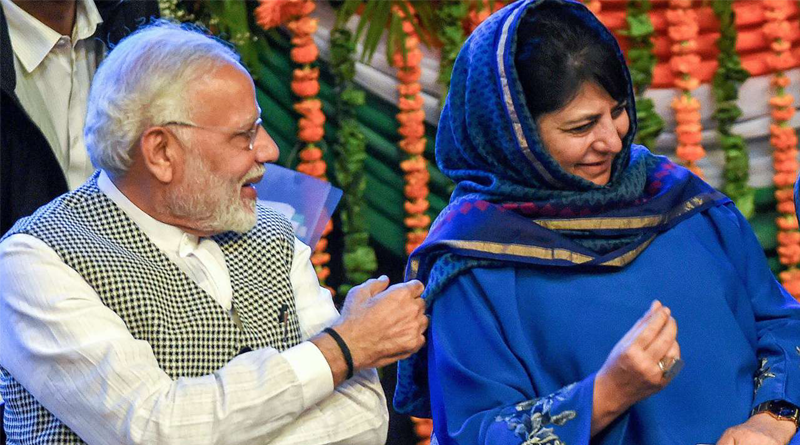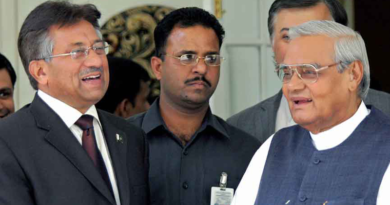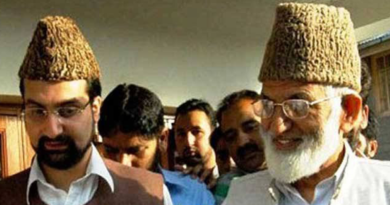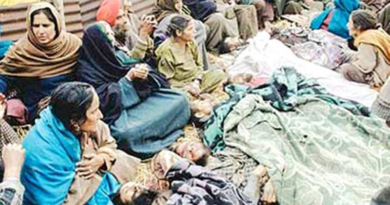Modi Has Tasked Mehbooba and her Henchmen with a Murderous Mission in Kashmir
As I write these lines, the current uprising has entered its third month. By all standards it is an extraordinary feat defying expectations not only of foes, but friends as well, myself included. That said, we are not talking here of a show of performance i.e. how best the actors have performed, rather it is a people’s movement geared to the achievement of concrete objectives, our focus, therefore, should be how far the Movement has been, and/or is going to be, successful in delivering those objectives. That the Movement has sustained for so long is in itself a fact of enormous political significance, but, nonetheless, some areas of concern need to be identified, and the enemy’s strategy looked at. The points to be raised here are:
1) What have been the gains, and losses, if any, thus far.
2) What are the significant realities that have come to the fore, particularly those pertaining to the Indian state/political establishment.
3) What are the strengths and deficiencies that have shown up.
4) What are the enemy’s designs and how is it planning to make its moves.
For reasons of space, and immediate relevance, we will focus on (4), giving a summary treatment to (1)-(3).
As regards (1), a spirit of common purpose has been generated, and Kashmir Movement and issue have become further highlighted. Apart from that, the big gains have yet to be made.
As for the losses, that hardly needs a mention; the reign of terror unleashed by Indian forces resulting in scores of deaths and thousands of injuries – in particular blinding – is visible everywhere. However, a crucial distinction needs to be made between losses and costs. When a person loses his/her life in a disaster such as an earthquake, flood or road accident, it is an outright loss. However, if in the struggle for achieving a legitimate objective a life is apparently lost, it is, in principle, not a loss but a cost inevitably demanded by the objective. A loss can only be differentiated from a cost when the movement set out to achieve the objectives, actually delivers in real time
Coming to (2), two significant realities have emerged. First, the weakness of the Indian state and its powerful elites and second, the emergence of defiant Kashmiri youth, lately termed ‘3G youth’ (third generation youth) as a leading element of the current uprising. Both these things, particularly the latter need a detailed discussion where the phenomenon of 3G youth can be viewed in a wider time-space framework. As regards the former, it is the extremely rigid, and frozen-in-time thinking of its ruling class and powerful elites in politics, media and elsewhere that has exposed the fragility of the Indian state. The ability to bend is a sign of life: flexibility guarantees resilience; rigidity results from staleness, and leads to collapse under pressure. India’s rigidity stems from its long nurtured hegemonic ambitions, and frustration for which there are reasons, some immediate and some long standing, to which we will revert at a future date.
As regards the strengths and deficiencies, the greatest strength we have had since 1947 is the mass sentiment of liberation from India, rejecting its militarily imposed and politically sustained occupation of Kashmir. The 3G youth viewed in this historical perspective,represent a much more assertive, and defiant form of the same sentiment. These youth are often allegedly associated with stone pelting and regarded by India as militants, but one must understand that stone pelting is primarily an expression of defiance; it is neither militancy nor an armed activity: stone pelters do not mean to kill or maim. In spirit very powerful,though materially feeble, stone pelting is essentially a sharp statement asserting: ‘you cannot cow us into submission’ and resistance to forced submission is an exclusively human quality; animals once controlled, do not resist.
Our deficiencies are mainly on the political front and relate primarily to organization, vision, political understanding and awareness, strategic sensibilities, and clarity of goals. I have referred to this in my earlier writings also and will return to it in full detail at an appropriate time.
Now to our final point, namely, what lies ahead. The answer to this question should not be difficult to find, given the fact that our relation with India is almost 70 years old, and we know how India has been dealing with Kashmir. However, some new things need to be noted
First, let us examine the oft-repeated mantra of ‘Kashmiriyat’ (Kashmiri culture, ethos and territorial identity), ‘Jamhoriyat’ (democracy), ‘Insaniyat’ (regard for universal human values) (henceforth KJI). This is presented as a framework for the solution of the Kashmir issue. That however, is a grave mistake. Kashmir is a political issue and as such requires a solution, mechanism, process and an overarching framework defining the four walls within which to operate. KJI is no framework, it is a deceptive catch-all designed to dodge real solutions, all the while maintaining an illusion of concern. For example, if India offers Kashmir internal autonomy (pre-1953 position) claiming that it falls within the ambit of KJI framework, we would ask what puts the accession to Pakistan or other alternatives for that matter, outside this ambit. Intrinsically meaningful, KJI is actually used as a combination of sound bites, yet carries no practical value. So, does that mean we should dismiss it as rubbish? Not without first understanding its purpose. Namely, that there is a deliberate design behind it: India has had a robust Kashmir policy which hinges upon ‘how not to solve the Kashmir problem’, which in turn necessitates denial of the problem, use of all underhand methods to buy off loyalties and brute force to silence the rest. India apparently being a democracy, this criminal agenda has to be camouflaged by a narrative to serve public consumption, both at home and abroad. KJI is an integral part of this narrative as is the US imported element of ‘the war against terrorism’. Of late one more component has been added, namely, 5% versus 95%, and this one is not from the American head of state, it is from ‘our own’ Head of the BJP installed government in Kashmir, Ms. Mehbooba Mufti who, although so busy with having ‘Agenda of Alliance’ implemented through pallet guns on the streets of Kashmir, rose to the occasion and without waiting for one sanctioned by United Nations, conducted her own referendum, God knows when, where and how, according to which it is only 5% of Kashmiri population who do not want a peaceful solution of Kashmir issue, and, by implication, who are behind the current uprising. The rest 95%, as the findings of the referendum go, also want solution but peacefully, and are, therefore, not behind the uprising. These things, which would otherwise deserve to be laughed at, need serious attention as these smack of India’s murderous intentions and agenda in Kashmir. Narratives are constructed to justify subsequent action, as the saying goes ‘give the dog a bad name and hit it’. This practice is as old as human history itself and evil forces everywhere have resorted to it. If we only pick up two elements of the narrative now being designed, namely KJI and 5/95, we can get a fair idea of what the Modi government is tasking its cohorts in Kashmir with
Take KJI first. Recently in an interview with NDTV journalist Barkha Dutt, Mr Muzafar Hussain Baig, a key PDP functionary while talking about KJI, said “but there are some people who believe in Pakistaniyat, that is a 4th element here” (interview posted on You Tube on 24/8/16). By Pakistaniyat, as was clear in the course of interview, Mr Baig meant the pro-Pakistan political position regarding the future of Kashmir which he ascribed to Hurriyet, and particularly to Geelani sahib. This holds key to the murderous mindset originating from Nagpur. I find it outrageous to say the least. Why is it that ‘Hindustaniyat’ (the position that favours Kashmir’s accession with India) is well within the ambit of KJI,and Pakistaniyat is not? In all fairness, given that the political future of Kashmir is yet to be decided, any and every vision of Kashmir’s future is in itself absolutely legitimate, there can be good or bad visions but that is besides the point here. If pro-India positions can be accommodated within KJI, why can’t pro-Pakistan positions? Purely for the sake of argument, let us say ‘Pakistaniyat’ is not ‘Jamhoriyat’, it is not ‘Kashmiriyat’ but how come it is not ‘insaniyat’, the most universally overarching element of the three? Are people who according to Mr Baig believe in ‘Pakistaniyat’ subhuman asking for something which lies outside the pale of universally accepted human values? They are human beings, and Mr Baig knows that very well, but—-and that tells the whole story— the dog has to be given a bad name before being hit
Kashmiriyat, Jamhoriyat, insaniyat are not words, these are tools to justify policy and clear the road for further repressive measures. Now look at another instance of the use of these tools. This time, it is not Mr Baig, but his colleague, a senior member of BJP installed regime, namely Mr Haseeb Drabu. Recently after the visit of India’s All Party Delegation he issued a ground-breaking fatwa: Geelani has betrayed Kashmiriyat by not opening the door to some members of the delegation. Opening and not opening the door determines who is Kashmiri and who is not. How funny! Mr Drabu is not Mr Ghulam Nabi Sogami ( a cabinet minister in Ghulam Mohammad Bakhshi’s puppet government in 1950s), who would say “Flood waaloon ko goli maaro, sailaab zadoon ko imdaad karo’. Sogami said what he said because of being a school drop out, Dr Drabu is highly qualified individual who knows what Kashmiriat means, so why this ludicrous fatwa? The answer is simple: we are again making the mistake of going into semantics as if ‘Kashmiriyat’ is a meaningful word for Drabu, it is a tool he was using to isolate Geelani by casting him as non-Kashmiri. His colleague Mr Baig had already reduced him and all those holding pro-Pakistan sentiment to subhuman as well as non-democratic. Now come to their chief Mehbooba Mufti. What about her referendum? Nothing but nonsense, 5% violent and 95% peaceful is no ground reality, it is a construct meant to ‘legitimize’ a brutal agenda. She says 95% of Kashmiri population want a solution by peaceful means, and 5% want it by violent means. If she was really reporting a fact on the ground, I would correct her saying , 100% Kashmiris want the solution of Kashmir issue by peaceful means, not only 95%. The big question, however, is, where is that solution? The ease with which she announces the findings of her referendum would have one believe as if the lady, like an iconic hermitess, was stretching forth her arms to shower the bounties on the waiting crowds, with one hand open and a beautifully decorated and gift-packed Kashmir solution placed on the palm for any mortal to freely grab, the other hand fully clenched with a Kashmir solution hidden inside in such a way that to obtain it one had to go through the valleys of death and torture. 95% people were going for the packed solution on the palm of the hermitess, but 5%, seemingly bitten by a mad dog, were holding them back to obtain the solution from the clenched fist.
Clearly this is nothing but mythology; a peaceful Kashmir solution has not been present for the past 70 years. It has cost Kashmiri people tens -if not hundreds- of thousands of lives but no solution has come forth. However, Mehbooba Mufti’s 5% figure cannot be ignored as rubbish, it is an important construct in the BJP’s new narrative to kill Kashmiris
We need to now look at the integrated picture. In any mass movement, every person is not an initiator. Rather, someone issues the call and someone responds. Together they make up a team and once the team is made, it becomes irrelevant to look for the individual characteristics of the constituting elements, that is, the caller and the responder. The team is now a structured whole. Likewise in Kashmir, there are some people more active than others, but together all the people form a functional whole, and the demand for India to vacate comes from this whole. India’s top priority is to break the unity of this whole and the narrative is geared to that end. However, India faces a fundamental problem: the current uprising lacks a definitive structure which although a weakness, has also been its biggest strength and almost a guarantee for its survival: the enemy cannot catch it by jugular and choke it to death. In this frustrating scenario, India, taking input from its intelligence agencies and its local clients in Kashmir, is planning to liquidate what it thinks is the hard core element in the Movement. Already, as we noted, Messrs Baig and Drabu have been trying to isolate this element by supposedly excommunicating them from the pale of KJI. Now their Chief is quantifying it at 5%. The truth is that this is all delusional and does not reflect objective ground realities. There are no hard and soft core elements in the crowds on the street of Kashmir, this distinction has now disappeared over a period of years.
To conclude, India must not tread the beaten track, it should heed Atal Behari Vajpayee’s advice, who in his famous Musings in 2001 wrote: “ In our search for a lasting solution to the Kashmir problem, both in its external and internal dimensions, we shall not traverse solely on the beaten track of the past. Rather, we shall be bold and innovative designers of a future architecture of peace and prosperity for the entire South Asian region.”
***
Dr. Syed M Inayatullah Andrabi is a well-known figure in the circles of political Islam. Born in Srinagar, the capital city of Indian Held Kashmir, Dr Andrabi has been intimately involved at the intellectual level with the global politics and political issues since his student days in 1980 at Pune (India), where he completed his Ph.D. in Linguistics in 1983 at the Centre of Advanced Study in Linguistics, Deccan College, University of Pune, Pune, India. Upon completing his doctorate he returned home to join the University of Kashmir, first on a post-doctoral fellowship and later as faculty, but could not continue because of the deteriorating security situation in Kashmir, and had to move to United Kingdom in 1994 where he continues to live since along with his wife and five children.




